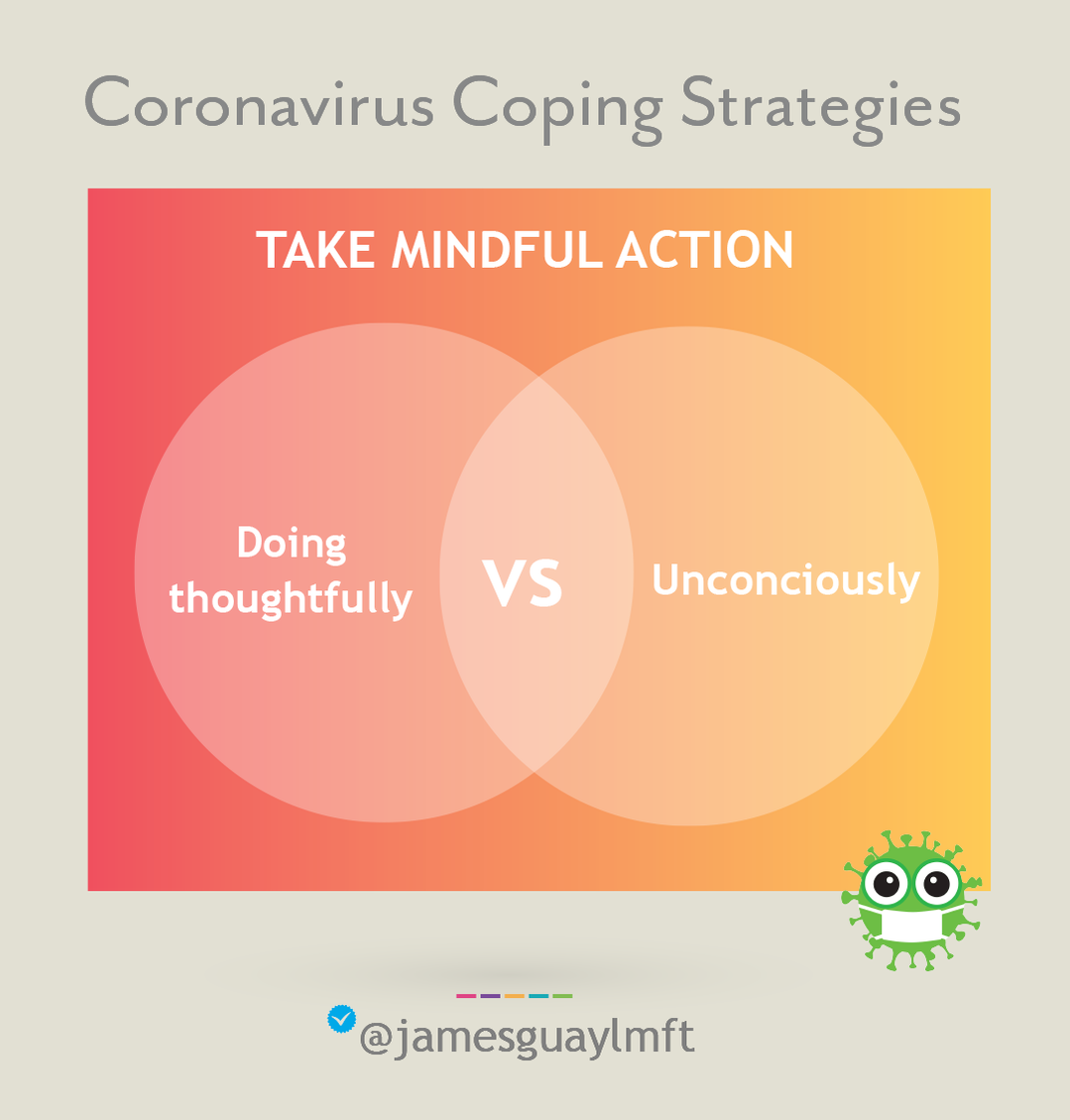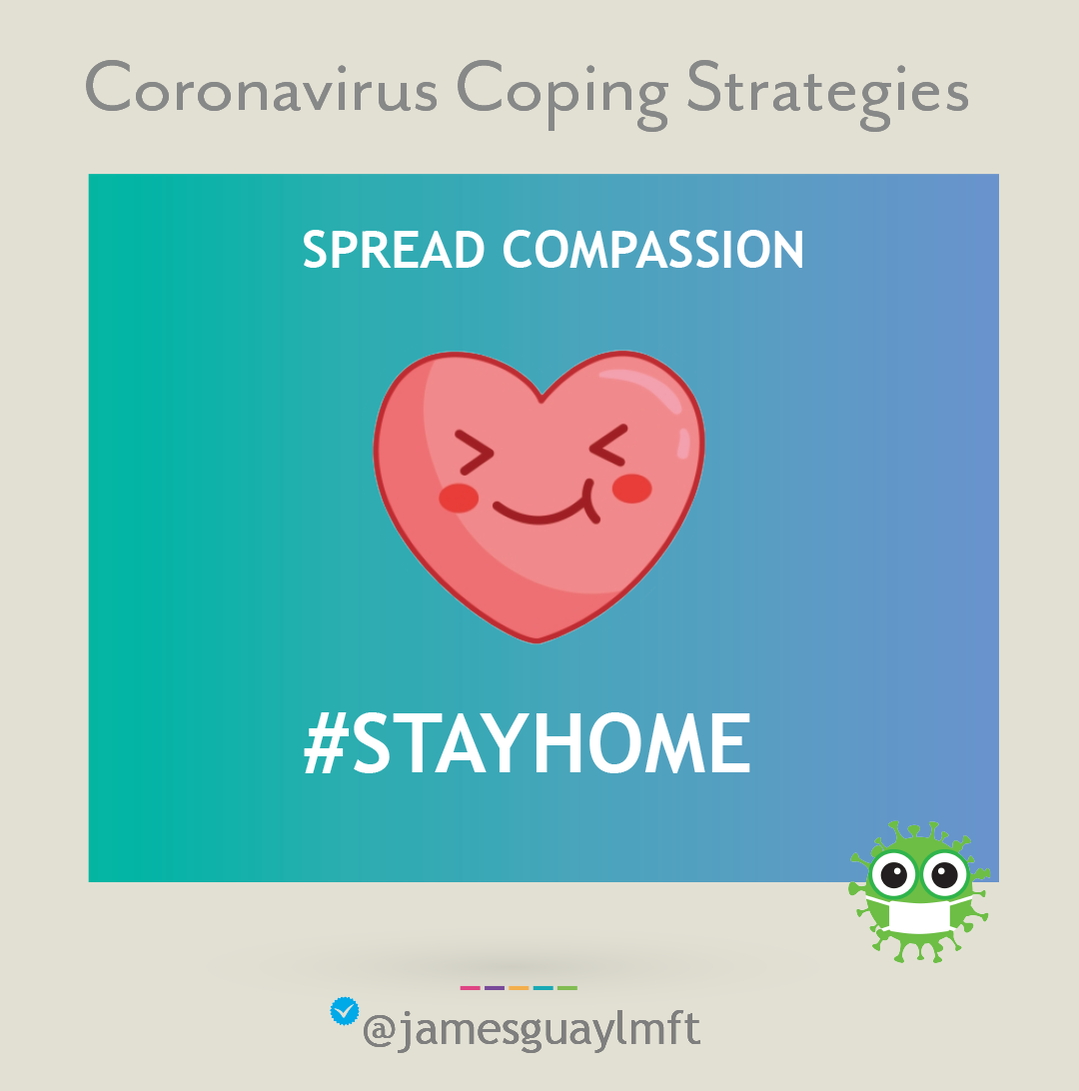Coping Strategies for Responding to the Coronavirus Pandemic
COVID 19 has transformed our world. Not only has it led to spiked infections, it’s also instilled mass hysteria, global grief, worldwide trauma and a huge stop to our everyday normal routines. So, how do we cope with a worldwide pandemic given our fears of infection and spread? How can we practice greater compassion at a time when we fear limited resources? How can we take into account the impact of our actions on others who may be more vulnerable than us?
1. Increase Self-Awareness
The first step to managing our COVID 19 stress better is getting ourselves off auto-pilot by increasing our self-awareness. Let’s call this what it is, again. We’re experiencing collective trauma and grief on a worldwide level. We’re responding to this with panic, fear, disbelief, hopelessness, numbness, denial, hoarding behaviors, and a wide variety of other thoughts, feelings and behaviors.
We first need to know what we’re dealing with internally and the best way to do this is to bring a sense of curiosity, without judgement. When we criticize ourselves for our reactions, it’s not safe for those things to come into conscious awareness. If we don’t create enough safety for us to feel what we feel, think what we think, and sense what we sense, then they will operate at the mercy of our unconscious, out of our awareness. Unaddressed, they’ll wreak havoc on our lives, like this coronavirus has. Mindful curiosity, without judgement, is the first step to treat what is bothering us mentally, emotionally, and spiritually. 2. Attend to Thoughts, Feelings & Body Sensations
Attending to our thoughts, feelings and physical sensations we gather information about what’s going on inside and our reaction to this current environment. Sometimes we can sense our physical reactions first, like whether our heart is beating fast, we’re flushing red, or we have shallow breathing and muscle tension. This can lead us to recognize that our body’s nervous system is acting like we’re perpetually in a fight, flight or freeze mode. When there’s nothing to do but stay-at-home there’s often no discharge of this kind of energy within us and we can collapse into exhaustion and depression.
Attending to our internal landscape, we need to acknowledge what’s there, allowing for whatever exists without trying to force it to be different. When we reject what we find or judge it, it often gets more intense and lasts longer than it otherwise would. Next, by naming what we find we get closer to identifying it and attending to it in ways that are needed. We then need to be with what we find in a balanced way, not denying/minimizing/ignoring but also not overindulging/obsessing/ruminating. We need to give it the space and time it deserves to inform us of what’s going on so that we can take appropriate actions, if any, and let it flow through us into something different. Sometimes, despite our best efforts, we just get hooked by whatever it is and it needs to take its natural course for longer than we’d like. While attending to our thoughts, feelings, and body sensations we also may need to self-regulate in multiple ways:
3. Take Mindful Action
Before we take any actions, let’s ask ourselves, is this the best course of action right now? Sometimes we’re doing something just to do something, and it’s not actually what we need. Other times, we are in producing mode in an attempt to justify our worth and value. I’ve had to even pace myself in writing this and take longer than I’d like to, because I recognized that I needed my own downtime first in order to process everything that’s going on and take care of myself in the ways I’m encouraging you to do here.
There are lots of great lists out there about what kinds of activities we can do while staying at home. We don’t have to do any of these things but rather whatever feels supportive and nurturing right now. Here are a few that speak to me but please use this as a jumping off point for you to get creative and that are specific to your environment and needs (see my compiled links to some of these resources at the bottom of this blog):
4. Create Down Time
We are at an opportune time for a global reset on how we manage our time. For far too long, and really since the Industrial Age, we have promoted production and DOING at the expense of balance and BEING. Both doing and being are essential in living a full life but when they’re out of balance we’re more likely to experience illness, burnout, boredom and overall dissatisfaction in life.
We need to slow down to do more. If we’re over-producing and over-working, there comes a place of diminishing returns. We can lose our creative spark, concentration and focus. We lost connection with our life force that replenishes us and keeps us inspired. For a more balanced life, we need to be clear about what’s most important to us, take action based on these goals, take in the nourishment from doing this, and then rest in order to recuperate. When we circumvent this process and don’t allow enough down time, especially during crises like we’re currently experiencing, we increase our suffering. Down time can include sitting and doing absolutely nothing. It can also include doing very little or slowing down using our five senses:
5. Spread Compassion
We are all in this together, even if we have differences in how it affects us given our specific circumstances and vulnerabilities. We’re all in this together despite our responses. Some of us are on the front lines providing essential services. Others are in self-quarantine to prevent spreading this infection. There are still some of us who are denying the gravity of all this or not caring about the impact of our exposure to others in our communities. It brings out the best and the worst in us.
This moment can magnify our soft spots and increase our anxiety, depression, loneliness, suicidal thoughts/actions, and relationship conflict including domestic violence and abuse. It can engender harmful racism, discrimination and xenophobia. There are many LGBTQ youth and adults that are not in safe homes during all of these stay-at-home orders. This moment in time highlights our wealth inequality and the systems that support it. Hyper-capitalism, hyper-individualism and extreme religiosity are systems that make it difficult to adapt appropriately to a pandemic. Mindfulness WITH compassion is the antidote for what ails us. When we increase our awareness in the present moment with curiosity, instead of judgement, and bring compassion to whatever we discover, we can navigate our response to real-life threats, like pandemics. We honor our organic response, get to know it, be with it and create space inside for how we can care for it with gentleness, grace and even fierceness. It takes both tremendous courage and vulnerability to do our internal work, especially at a time like this. This isn’t a time to gloss over our collective fears, grief and trauma or to do a psychological or spiritual bypass where they go unattended. Quite the opposite, it’s a time to use whatever exists for us naturally, pain and all, to heal, learn and grow. It’s a call to action that we’ve needed to become more caring of ourselves and each other. It’a a reset to come back to our common humanity and address destructive othering of each other. It’s a time to wake up to our inherent goodness, worth and value. From this place, we can be kind. From this more centered place we can come back home to ourselves and extend that grace to others around us. Channel Q Radio's The Morning Beat Interview
Listen to my conversation on Channel Q Radio's The Morning Beat with AJ Gibson & Mikalah Gordon about my COVID-19 Mental Health Survival Guide.
PodcastThe FIGHT MagazineGoogle SlidesStay-At-Home Resources
Please add your own in the comment section below
Online Yoga:
20 Black Yoga Instructors Heather Dawn Alex Dawson Jake Ferree Online Meditations & Teachings: Den Meditation & Classes Insight LA Meditation Mark Coleman Tara Brach The Power of Self-Compassion Course (Kristin Neff & Chris Germer) Free Half-Day Mindfulness Retreat at Home (Tara Brach & Jack Kornfield) Online Dancing Resources: Club Q for the LGBTQ Community Ryan Heffington's Instagram Live Streaming Dance Classes Various Ballet Classes Maria Khoreva's Ballet Classes Dance Vision for Ballroom Dancing Online Learning (Photography, Video Blogging, Software, Musical Instruments, etc): LinkedIn Learning (formerly Lynda.com) Great Courses Plus Udemy Fluenz: Learning a New Language Arts & Culture: Ballet Across the World Art Museums Across the World MetOpera On Demand Donating: WHO COVID-19 Solidarity Response Fund N95 Masks Mental Health Support: National Suicide Prevention Hotline Trevor Project COVID 19 Facts/Science: World Health Organization Centers for Disease Control & Prevention Chad Ruffin, MD
6 Comments
Pamela Payton, LMFT
3/30/2020 05:57:08 pm
Wonderful advice and well written. Love the resources and color in the pictures. Thank you.
Reply
James Guay
3/31/2020 02:13:06 pm
Thanks so much for your ongoing support and feedback Pamela! Happy to hear you found this blog useful.
Reply
John Support
3/26/2024 07:39:47 am
Great work on your blog post! It was evident that you put effort into structuring the content in a logical manner. I enjoyed the clarity of your explanations and the practical applications you discussed. To learn more about this subject, <a href="https://1b020cogkovuetd2mdqy5g42p4.hop.clickbank.net" target="_blank">click here</a>.
Reply
3/30/2020 11:14:10 pm
Wonderful guide. Well written and practical. Thank you.
Reply
James Guay
3/31/2020 02:13:54 pm
Thanks Isabell! Happy to support your efforts too.
Reply
Leave a Reply. |
Categories
All
Archives
March 2022
�
|







 RSS Feed
RSS Feed